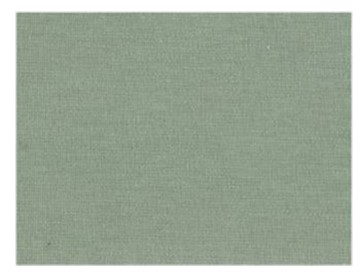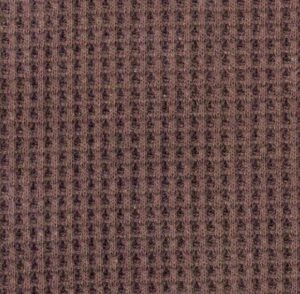Double Knits
Double-knit fabrics are heavier in weight because they are composed of two separate fabrics linked together in the knitting process. This type of fabrication uses more yarn, which increases the cost of the fabric. Double knits tend to be more stable and curl less than single knits. Common double-knit fabrics are interlocks, rib knits, Ponte di Roma, and double-knit jacquards. These fabrics are great for heavier knit garments that require structure or are used for layering.
In this section, we will look at the needle bed set-ups for knitting ribs and interlocks and review the capabilities of double-knit jacquards.
-

Notation for a 1x1 rib.
-

Notation for a 2x2 rib.

Ribs and Rib Gaiting
Ribs are classified as double knits because they require two needle beds. On a circular knit machine, the needle beds are on the cylinder and the dial. The arrangement of the needles needs to be rib gaited. In the diagram of the 2 x 2 rib, you see how the needle arrangement gaits, and the stitches alternate between two knit stitches on the cylinder and two knit stitches on the dial. This construction is a traditional 2 x 2 rib.
Ribs have the same appearance on the front and back of the fabric. The extensibility in the width direction stretches to twice that of a single jersey. The fabric does not curl if knit correctly but runs or unravels from the last knit.
Ribs can be very fine in gauge or very heavy and chunky, depending on the type of machine used to knit. V-bed machines are used for chunkier or heavier gauge ribs like those on sweaters. To control the tension of ribs, a stretch yarn is sometimes added to aid in recovering the fabric shape.
Rib Gaiting involves spacing the needles between the dial and the cylinder to achieve the desired knit construction. With rib gaiting, the two sets of needles are not directly opposite each other; the needles of the cylinder are between the needles of the dial. Both sets of needles can knit simultaneously without touching or hitting each other.
Although all needles have the same length, the butts are in two different locations, which activates the needles to create the patterning. Rib gaiting results in a fabric where the face and back loops alternate in the same course.
Needles on the cylinder make a face wale, and needles on the dial make a back wale. Look closely at the structure of the fabric, and you see that a vertical line, or wale of visible crowns, is arranged between two lines of vertical lines of visible legs. A 1 x 1 rib construction appears the same on both sides of the fabric.
There are different notation systems for needle selection. This example shows how the knit loops alternate one by one on the dial and cylinder needles; this notation is for a 1 x 1 rib. The second notation is for a 2 x 2 rib.
Notice that for each feed of yarn, two loops produced on the dial alternate with two loops produced by the cylinder. Note that with this configuration, only needles with long butt positions knit, while the needles with short butt positions do not knit.
Because basic rib knits alternate face and back wales, the structure can easily be stretched. In a normal relaxed state, the back wales hide behind the face wales.

When stretched in width, the structure opens like an accordion, resulting in more stretch than single knits and other double knits. The back wales now become visible. When pulled in the length direction, the back wales move behind the face wales, and the fabric becomes narrower. Because of this extensibility, basic ribs are used for dresses and sweaters, and the trim of neck collars, wrist, and waistbands.
Interlocks and Interlock Gaiting

Image of an interlock fabric. Notice the subtle rib structure.
Interlock gets its name from the “interlocking” of two 1×1 rib fabrics together into one fabric. Interlock repeats on every two feeds, whereas ribs repeat on one feed.
Notice that the needles are not in the gaited positions but are opposing. The needle activation alternates between the cylinder and the dial to avoid the clashing of needles.
Interlocks have the same appearance on the face and back and are very stable fabrics with no curling. When knitting with combed cotton yarns, these fabrics can be very soft with applications for dresses, baby clothes, and close-to-the-body garments like turtlenecks.
A second type of gaiting where needles are placed opposite of each other is Interlock Gaiting. In interlock gaiting, cylinder, and dial needles are spaced so that they are directly opposed. To prevent needles from hitting each other during the knitting cycle, opposing needles are not selected simultaneously. When needle 1 in the cylinder knits, the corresponding needle 1 in the dial must rest; this is achieved by the alternating needles in the dial and the cylinder never being activated simultaneously. Interlock gaiting requires two cam tracks for both needle beds. Therefore, the location of the butts on the needle shank must be in two positions.

Interlocks require 2 feeds to make one visible course.

In interlock gaiting, the needles are placed opposite each other but do not run simultaneously.
The most commonly used needles for interlock gaiting have butts in short and long configurations. Needles with long and short butts are alternatively arranged in the cylinder and dial.
During each feed or coarse of yarn, only half the needles are used. On course one, only needles with long butt positions knit those placed in odd positions of the cylinder and even positions of the dial. On the second course of yarn or feed, the short butt position needles knit those placed in even positions of the cylinder and odd positions of the dial. Two feeds are required to complete a full stitch of an interlock knit, whereas in a 1 x 1 rib, knitting only one feed completes the stitch structure.
In the illustration, the first colored yarn (grey) knits on odd dial and even cylinder needles. The second colored yarn (black) knits on odd cylinder and even dial needles. Because loops interlock and alternate from the front to the back, the structure of interlock fabric is more rigid and stable than that of a rib. At closer inspection, you can see that interlock is the meshing or interlocking of two 1 x 1 rib courses. This prevents adjacent wales from having mobility.
Different double knit constructions can be made on rib and interlock-gaited machines. Needle selection by mechanical and/or electronic systems and yarn selection determines the design effect.

In interlock gaiting, the needles are placed opposite each other but do not run simultaneously.
Ponte di Roma
A variation of an interlock knit can be used to produce a structure that is tight and stable, where one course of fabric is attached and interlocked while the next is not. Ponte de Roma is an example of this type of textile.
This fabric has the same appearance on both sides. Here is the notation for this type of fabric. During the first two feeds, the machine knits interlock. With the third feed, the machine knits jersey on only the cylinder needles. On feed four, the machine knits jersey only on the dial needles. It takes four yarn feeds to make two visual courses. Although smooth, Ponte de Roma has a slight horizontal rib appearance and is thicker and more stable than interlock. Ponte fabrics offer good stability and recovery, especially when knit with spandex yarns. These fabrics are commonly used in tailored knit garments that require structure, like trousers and jackets for both men and women.
-

Ponte de Roma
-

Notation for a Ponte di Roma fabric.
Double Knit Jacquard
-

Example of a double-knit jacquard. Notice the front and back patterns are different.
-

Example of a double-knit jacquard. Notice the front and back patterns are different.
This three-color double knit jacquard has two separate knit patterns, one on the face and one on the technical back. This double knit pattern takes three feeds to make one visible course.
As opposed to single knit jacquards, where the non-visible colored yarns are hidden on the back as floats, double knits hide the unused yarns as a separate knit structure. In this example, the technical back is knitted into a birdseye pattern.
Double knit jacquards tend to be heavier in weight based on the yarn size and use more yarn than single knit jacquards, which adds to the cost of the fabric.
Thermal
Thermal fabrics are traditional double knits that are commonly used as base layer garments to provide warmth. This fabric is created by knitting and tucking on the dial and cylinder.
The combination of tuck and knit stitches creates cellular pockets with insulating properties for warmth. Due to the many tuck stitches in the construction, thermal fabrics lack stability, grow in width, and shrink in length.



